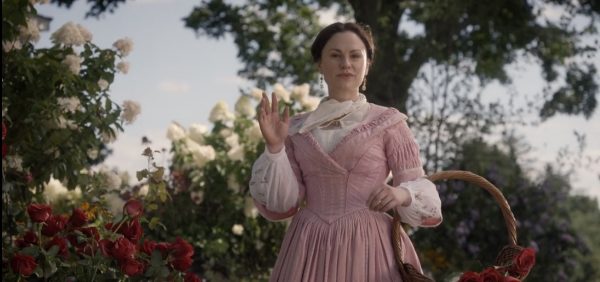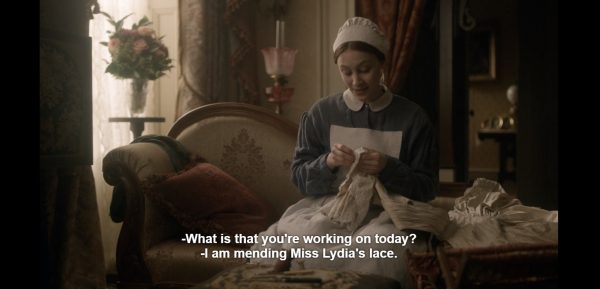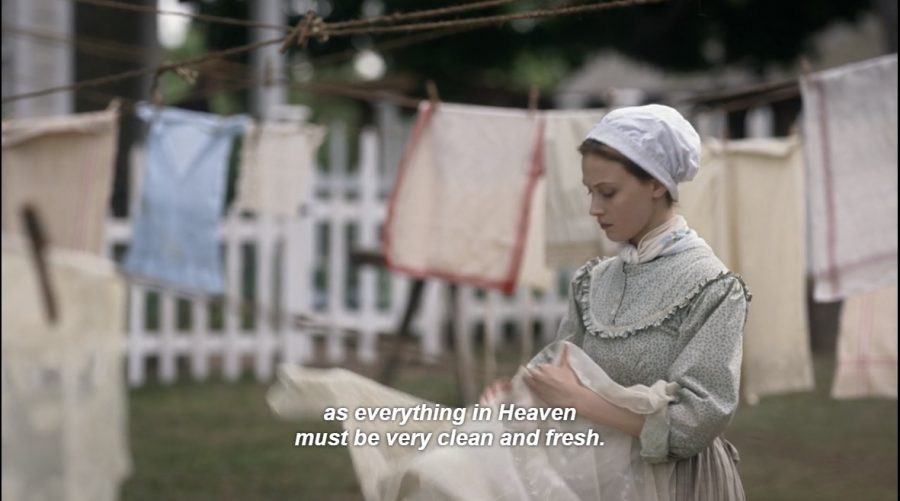‘Murderess… the word has an odour, musky and oppressive; rustles across the floor like a taffeta skirt’
– Alias Grace (1996, Margaret Atwood)
Fabrics play a huge role in Alias Grace. All through the book and the show, a distinct sub-text prevails: That of patchwork quilts and patterns, of designs and superstition, a mosaic of scenes and snippets that may or may not form a coherent whole.
Alias Grace‘s Sarah Gadon embodies the Atwood woman in spirit. She is prosaic and poetic all at once; talks of lovely evenings, so beautiful that they make her sad, of the pleasure to be had in the sight of fresh laundry rippling in the air, of apples and parsnips and beets that have a different texture when boiled. She talks of a bloody petticoat from her first period, her pretty embroidered handkerchief that was found wound around the neck of the murdered housekeeper whose household she was a part of, a sample of cloth from the gown of her corpse. She talks of fashioning lovely cuts of triangles from the clothes and weaving them all into quilt that she would make for herself. It would ripple and billow in the air someday just as the others do. The triangles would occupy the centre of the tree of paradise, a pattern she loves. Or perhaps, I would make an old maid’s puzzle, she tells the doctor who has come to review her case, and diligently takes notes of what she says. “I’m an old maid, don’t you think, sir, and I’ve been very puzzled.”
Grace sews, fiddles with the thimble as she says this, glances at the doctor from under her lashes steadily scratching away at his book, smiles. She knows he’s smitten by the tale that she weaves. And by extension, herself. At times, Grace, clad in a roomy blue pinafore with a flat Peter Pan collar, wets the thread between her lips to sharpen the edge. Dr Simon Jordan listens, a perfect sample of gentleman wardrobery – a tie and a coat. It’s classic representation of Grace’s thoughts about him – refined, avuncular, decidedly dispassionate but not entirely unfeeling. She smiles as he flinches at her miserable past, presses on in a low voice.
 A textbook example of post-modernist literature, Margaret Atwood’s Alias Grace on screen, based on the 1843 real life murders of Thomas Kinnear and his housekeeper Nancy Montgomery in Upper Canada, is terrifyingly subliminal in the portrayal of its protagonist. There’s violence in the peace, a precise, clinical loveliness to the frames that works below consciousness to arouse dread.
A textbook example of post-modernist literature, Margaret Atwood’s Alias Grace on screen, based on the 1843 real life murders of Thomas Kinnear and his housekeeper Nancy Montgomery in Upper Canada, is terrifyingly subliminal in the portrayal of its protagonist. There’s violence in the peace, a precise, clinical loveliness to the frames that works below consciousness to arouse dread.
Grace Marks, an Irish immigrant and convicted murderess, with an abusive, lovelorn and poverty-ridden past, works in the scullery of the notoriously-reputed Scottish gentleman with a snowy, clipped beard. It makes for pleasantly creepy characterisation. When she meets Mr Kinnear for the first time, he punches a man in the gut for making advances towards her. He looks thorough, light travelling coat and a well-poised hat, helps her up the carriage, sits next to her as an equal. They drive down Yonge Street to his farm. Nancy Montgomery, whose acquaintance Grace had made a few days before, is gowned in elegant peach tones when Grace sees her first. Soft muslin and a fine set of teeth, gold earrings that catch the light of the sun. She reminds Grace of a dear, dead friend. Arriving at the Kinnear household a little later, Grace is conflicted; Nancy, picking flowers in the garden, wears the pink of roses, with a bonnet cinched in elaborate satin. Flashy, jarring and worldly to her grey plaid skirt, Grace observes that she isn’t too welcoming.
 Atwood, in her book, names chapters after quilting patterns, a few of which are described in great detail. She writes about cut and borders – of Wild Goose Chase and Vine – quilts for the married and quilts for the matrons. Fabrics take on a distinctive literary quality as well; they are used as metaphors like in here, to describe sounds – “There is great pleasure to be had in a wash all clean and blowing in the wind; the sound is like the host of the Heavenly Hosts applauding – though from far away. They do say cleanliness is next to godliness.” They are also employed to be evocative of a particular smell. Mrs Humphrey, Dr Jordan’s forlorn landlady who would love to have him in her bed, is said to bear a “hot dry smell like that of white linen being ironed.”
Atwood, in her book, names chapters after quilting patterns, a few of which are described in great detail. She writes about cut and borders – of Wild Goose Chase and Vine – quilts for the married and quilts for the matrons. Fabrics take on a distinctive literary quality as well; they are used as metaphors like in here, to describe sounds – “There is great pleasure to be had in a wash all clean and blowing in the wind; the sound is like the host of the Heavenly Hosts applauding – though from far away. They do say cleanliness is next to godliness.” They are also employed to be evocative of a particular smell. Mrs Humphrey, Dr Jordan’s forlorn landlady who would love to have him in her bed, is said to bear a “hot dry smell like that of white linen being ironed.”
Clothing is also used a lot to reinforce character. Mary Whitney, Grace’s friend and confidante who presents her with a patterned kerchief on Christmas, has sharp eyebrows, a face not shorn of bony adolescence and a generally cheerful disposition. She’s sunny, often seen in the brightest of scenes, her apron decidedly white. George Parkinson, the son of the household, to whose advances she submits, has a gold chain twinkling over his coat. When Mary dies of a botched abortion, deliberately misled and used by George, Mrs Parkinson, his mother and the mistress of the household, is seen in a stuffy maroon gown that poufs over the arm. She bribes Grace into silence, presses a crisp note in her palm.
*****
Dr Simon Jordan, who seems both enchanted and repulsed by his patient, gradually becomes more involved in the tale she spins, needle, thread and thimble in rhythmic motion. He takes a fancy to her, begins fantasising. A risqué theme for the time the book was set in, it turns the psychologist-patient relationship on its head. Dr Jordan doesn’t quite know if he believes in her constructs; her tale seems deliberately thought-out, yet with a carefree innocence that he can’t quite place. In the novel, Atwood describes him as unpretentious. “He hates cravats and stocks and wishes them at the Devil,” she says, “he resents his trousers as well and all the stiff and proper clothing generally. Why does a civilized man see fit to torture his body by cramming it into strait-jacket of gentlemanly dress? Perhaps it’s mortification of flesh like a hair shirt. Men ought to be born in little woolen suits which would grow with them over the years thus avoiding the whole business of tailors and their endless fussing and snobberies.”
 In Alias Grace, bonnets are subject to social class, too. Nancy Montgomery lends her elaborately fashioned one to Grace to wear on her birthday. Have the afternoon to yourself, she says. During other times, they make for a handy ruse. When Dr Jordan wonders why Grace doesn’t describe Mr Kinnear particularly to him, she blames it on her bonnet. “I didn’t wish to gape at him, sir,” she says, “And, I needed to turn my head because of the bonnet. I suppose you haven’t worn one, have you?”
In Alias Grace, bonnets are subject to social class, too. Nancy Montgomery lends her elaborately fashioned one to Grace to wear on her birthday. Have the afternoon to yourself, she says. During other times, they make for a handy ruse. When Dr Jordan wonders why Grace doesn’t describe Mr Kinnear particularly to him, she blames it on her bonnet. “I didn’t wish to gape at him, sir,” she says, “And, I needed to turn my head because of the bonnet. I suppose you haven’t worn one, have you?”
No, says Dr Jordan, I suppose it’s very confining.
Much later, towards the end, Grace’s clothes see a dramatic transformation. In the final episode, she no longer wears blue, but a flowing black gown that fans out prettily across her lap. A dark veil over her head sets the mood for what is to come – a hypnotherapy session that seems to blow a new personality into Grace – vile, sinister, jeering. Did you help strangle Nancy, Dr Jordan asks of her. “It was my kerchief,” she twitters, “It was a shame to lose it. It was my mother’s and such a pretty pattern it had on it, too.”
*****



